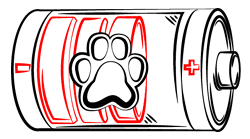
Paws ‘N’ Pups Quickview
Size
| Energy Level
| Trainability
| Paws ‘N’ Pups Rank
|
Characteristics
| Physical Characteristics: Height: 23-26” Weight: 55-85 lbs. Energy Level: High | Colors: The American Kennel Club recognizes the in the following colors:
|
| Health & Longevity:10-12 years Breeders screen for the following conditions:
Weimaraners are susceptible to gastric torsion (bloat), a life-threatening condition if immediate veterinary intervention is not sought. Ear infections are also common. | |
Temperament & Train-ability
Weimaraners are an elegant looking but demanding breed. Originally bred to hunt big game, they were eventually used primarily for small game. Intense and high strung, Weims (an affectionate nickname) can make good family dogs with older, active children; they are too rambunctious for toddlers. Just as your dog will need careful socialization to learn appropriate behavior around children, your children must be taught how to properly interact with your Weim. Never allow children to sit on, attempt to ride or pull ears, etc. Children should be taught how to recognize when a dog needs a break and give them space.
The households Weims fit into are willing to accommodate their extremely high energy level, need for exercise and near-constant companionship. A minimum of two hours of hard exercise and mental stimulation are needed in order to avoid behavior problems such as nervousness, neurotic or destructive behavior. Their energy is matched by their intelligence, which is a troublesome combination; they easily find ways of their own to burn off energy and stimulate their minds if you don’t supply it. Inappropriate chewing, food stealing, counter surfing, barking and other generally undesirable behavior awaits the poor soul who does not see to their Weim’s needs.
Weimaraners possess a natural suspicion of strangers and can be inappropriately aggressive if not handled correctly. Extensive socialization is necessary to counter this and help them realize not everyone is a threat. They generally make good watchdogs, but are unsuited to apartments, condos, or those with small yards. Novice dog owners will be completely unprepared for this breed’s high-strung nature. Weimaraners can be very dog aggressive and predatory with small animals and small dogs. A Weimaraner should never be allowed off leash as their hunting instincts – or the simple joy of running – can surface and they will be gone.
Weims are so highly attached to their people that they are prone to separation anxiety, so are unsuited to spending long hours alone or living in a kennel with little human contact. Commonly referred to as “Velcro dogs”, for their tendency to always want to be touching you; some find this endlessly endearing while others are driven nuts by it. Their high prey drive makes them unsuitable for living with cats; indeed, even small dogs can be problematic, and you can count on them wanting to chase wildlife. A tall, secure fence is a must as Weimaraners are escape artists and once at large are likely to get themselves into trouble chasing joggers, cyclists, etc. Do not rely on underground electronic fences to contain a Weimaraner.
Despite their elegant, aristocratic appearance, Weimaraners are certainly not for everyone. You’ll need a sense of humor, lots of time to devote to exercise and stimulation, and imminent patience. But for those who are a fit, these “ghost dogs” make fun partners. They can be great jogging and cycling companions, but wait until growth is over (around 24 months) to avoid causing joint damage.
Sensitive, intelligent and independent: this is a challenging combination of traits to train. Using positive reinforcement methods will certainly get you to your goals more quickly than force; it will also require some skill. Their high prey drive can be used to motivate and reward. Weims don’t respond well to anger but clear boundaries must be set. Weimaraner puppies will challenge even the most patient. Housetraining a Weim can be difficult; many owners opt for the use of a doggy door so that yard access is always available. Athletic Weimaraners can compete in sports like agility and flyball; venturing into traditional obedience will be challenging and a sense of humor needed, as well as an acceptance that high scores will probably not be in your future.
Grooming
The Weims’ short smooth coat is sleek and easy to care for; since dirt falls off, they stay very clean with little work. Bathing can be done, as needed, but most Weim owners just use a damp rag to freshen up their dogs. Weekly brushing with a curry or soft bristle brush will keep the normal shedding to a minimum. Because Weimaraners are prone to ear infections, special attention should be given to keeping ears clean and dry. Toenails should be trimmed; even if your Weim wears their nails down, you will want to maintain the ability to handle their feet, especially useful as they age, when wear to the nails typically slows down. Teeth must also be checked and cleaned regularly.
Diet
The amount of food a Weimaraner will require can vary depending on age, activity level, and type of food fed. On average, they will eat 2 1/2 – 3 1/2 cups of food daily, fed in two meals; free feeding should be avoided. A constant supply of fresh, clean water must always be available.
Looking for a Weimaraner?
 Find A Weimaraner Breeder |  Weimaraner Puppies For Sale |  Adopt A Weimaraner |
Cost
Weimaraners can run from $600-$1,200. Breed rescues are very active, and are another option for acquiring a dog. Whether you acquire a dog from a breeder or rescue, do your homework to be assured that the temperaments of the dogs are tested and sound. Ongoing expenditures include the typical supplies, food, and regular vet visits.
Paws ‘N’ Pups Ranking
Paws ‘N’ Pups ranks every breed out of 4 with 1 being easiest to integrate into your life and 4 being the toughest – The lower the ranking the better.
Ranking takes into account a few basic factors such as cost, skill level needed, high vs. low maintenance, and how critical regular training is to success.
The Weimaraner rates a 3.5; their exercise and stimulation requirements are huge and they are not an easy breed to live with.
Breeds Similar To Weimaraner
 Pointer |  Vizsla |  German Shorthaired Pointer |  Golden Retriever |




